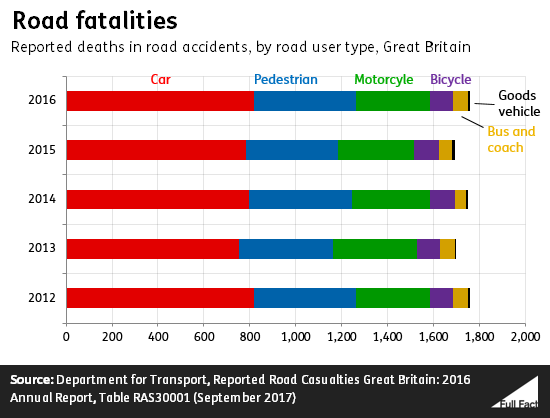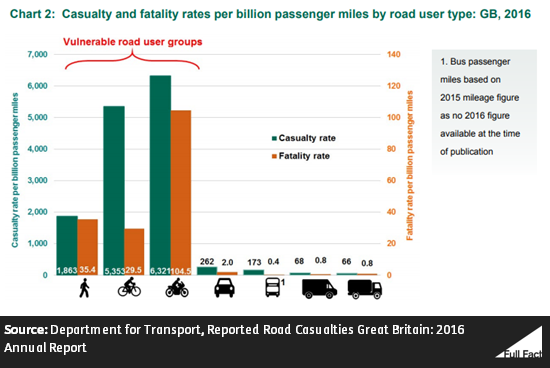What was claimed
In 2016, 18,477 cyclists were injured in road accidents, including 3,499 who were killed or seriously injured.
Our verdict
Correct for Britain. The 18,477 figure includes deaths, of which there were 102.
What was claimed
In 2016, 18,477 cyclists were injured in road accidents, including 3,499 who were killed or seriously injured.
Our verdict
Correct for Britain. The 18,477 figure includes deaths, of which there were 102.
What was claimed
Of the almost 1,800 deaths that occur on our roads annually, around 450 are pedestrians in incidents where motor vehicles are involved.
Our verdict
Correct. Refers to figures for Britain in 2016.
What was claimed
0.5% of pedestrian deaths are people killed by people on a bike.
Our verdict
Roughly correct, for Britain.
“In 2016 — 18,477 cyclists were injured in road accidents, including 3,499 who were killed or seriously injured.”
Jeremy Vine, 12 August 2018
“of the almost 1,800 deaths that occur on our roads annually, around 450 are pedestrians in incidents where motor vehicles are involved. Despite these overwhelming statistics, the government has chosen to focus their time and resources on the 0.5 per cent of people who are killed by people on a bike.”
Chris Boardman, 12 August 2018
Mr Vine and Mr Boardman are making the point that cyclists are some of the most vulnerable road users, and are relatively unlikely to cause a road casualty. The statistics support this.
Of those killed on the road in Britain 2016, 6% were cyclists, as were 14% of those seriously injured. Along with pedestrians and motorcyclists, the government classifies cyclists as “vulnerable road users” because they are significantly more likely to be killed or injured per mile travelled, compared to other road users.
The claims were made in response to a (now deleted) Conservative Party tweet (see screenshot here) which said “We’re launching a consultation into dangerous cycling so that our most vulnerable road users are protected.” A government minister apologised for the tweet about “dangerous cycling”, saying it didn’t reflect the policy it was announcing.
Very few pedestrian fatalities involve cyclists. Of the 448 pedestrians killed by a vehicle in 2016, three were caused by bicycles, compared to 289 by cars. These levels have been broadly consistent over the past five years.
However, the government thinks that the law on dangerous cycling is not as far-reaching as that on dangerous driving (it says it’s harder to prove the offence of death or injury caused by dangerous cycling, and it’s likely to carry a shorter sentence). It has launched a consultation into whether the law on dangerous cycling needs updating.
Join 72,547 people who trust us to check the facts
Subscribe to get weekly updates on politics, immigration, health and more.
102 cyclists were killed on British roads in 2016. Around 3,400 were seriously injured, and there were around 15,000 other casualties. This data won’t cover any incidents that weren’t reported.
Of the 1,792 people killed on British roads in 2016, almost half of them (816) were car occupants, 25% (448) were pedestrians, and 6% (102) were cyclists. Looking at those seriously injured, the proportion of car users falls (to 37% in 2016) while the proportion of cyclists rises (to 14%). These figures are broadly consistent over the last five years.

The raw numbers don’t tell the whole story, though, because car use is a much more common mode of transport than cycling or walking. Given that car drivers make up around 80% of the traffic on British roads, they are likely to make up a significant number of the casualties.
So another way to look at these figures is to ask how many deaths there are per miles travelled by a particular type of user. Based on this, the government identifies pedestrians, cyclists, and motorcyclists as “vulnerable road users”.

For every billion miles travelled, these three groups are far more likely to be injured in an accident, or to be killed, than any other group. The above chart, published by the Department for Transport, shows slightly different figures to those reported in the underlying data, but the broad impression is very much the same in both sources.
The government has recently pointed out that “There were 2,491 recorded collisions between cyclists and pedestrians (where no other vehicle was involved) that resulted in a pedestrian casualty between 2011-2016, of which 20 were fatal and 546 resulted in serious injury.”
This is correct, although proportionally very few pedestrian casualties involve bicycles. From 2012 to 2016, 2,120 pedestrians were killed by a vehicle in Britain—0.8% of these involved a bicycle, and 66% involved a car. In 2016, 448 pedestrians were killed by a vehicle—three of these deaths involved a bike, and 289 involved a car.

Almost 26,000 pedestrians were seriously injured by vehicles from 2012 to 2016. Two percent of these involved a bike, and 81% involved a car. In 2016, 108 pedestrians were seriously injured by a bicycle, compared to 4,156 by a car.
But why is the government doing this, if cyclists make up a significant number of casualties on the road, but bicycles cause relatively few pedestrian deaths? Largely, it’s because the laws on dangerous cycling are not as wide-reaching as those on dangerous driving.
Currently, cyclists charged with dangerous or careless cycling can be fined up to £2,500. In cases where a cyclist causes serious injury or death, they can be charged with “wanton or furious driving”, which carries a maximum sentence of two years imprisonment. This law was introduced in 1861, originally intended for horse and carriage driving, meaning it may not be appropriate for modern-day cycling cases, according to an independent legal review carried out for the government.
The government points out that there are a wider range of offences covering dangerous driving, including causing death by dangerous driving (carrying up to 14 years imprisonment) and causing serious injury by dangerous driving (up to 5 years imprisonment). It considers that there is a gap in the law, whereby it’s easier to prove dangerous driving in court than dangerous cycling—the “wanton and furious driving” offence only covers the extremes of dangerous cycling. It also notes that causing serious injury or death by dangerous or careless cycling is likely to lead to a shorter sentence than if caused by dangerous or careless driving.
It is therefore considering whether to bring in a new offence for dangerous cycling, equivalent to that of causing death by dangerous driving. At present, the government is seeking public consultation on whether to change the law.
Update 3 September 2019
This article was updated to clarify the language on deaths caused by bicycles.
Full Fact fights for good, reliable information in the media, online, and in politics.
Bad information ruins lives. It promotes hate, damages people’s health, and hurts democracy. You deserve better.